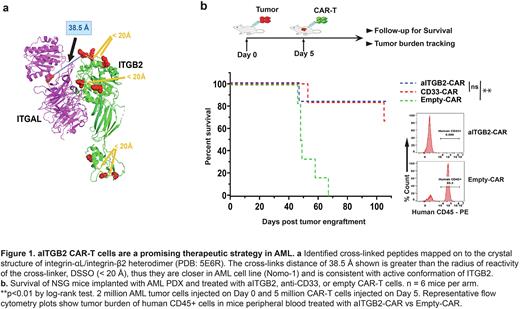Abstract
Background and Significance: Cellular therapies have led to immense excitement in cancer care, with CAR-T cells as the canonical example. However, the clinical reach of these "living drugs" is still limited. A major hurdle in this regard is the lack of cancer-specific surface markers. Here, we explored the hypothesis that tumor surface antigens may harbor cancer-specific protein conformations, invisible to standard target discovery strategies focusing on gene or protein expression alone, that may create selective immunotherapy targets. While one previous example existed in the literature (Hosen et al., Nat Med (2017) 23:1436), this was a serendipitous discovery not intended to find conformation-specific antigens. We thus aimed to develop a technology that could identify conformation-specific tumor antigens in a broad, systematic manner. We first focused on finding such antigens in acute myeloid leukemia (AML), given that current leading immunotherapy targets (e.g. CD123, CD33, CLEC12A) are also expressed widely on normal hematopoietic cells, leading to toxicities and an urgent need for targets with greater tumor specificity.
Results: Toward unbiased discovery of tumor-specific, conformationally-based cancer antigens, we developed a proteomic approach called "structural surfaceomics". This method sequentially integrates cross-linking mass spectrometry (XL-MS) with glycoprotein cell surface capture (CSC) to enable low-resolution structural profiling of hundreds of cell surface proteins in parallel. We used two different XL-MS crosslinkers: the mass spec-cleavable DSSO and the non-cleavable PhoX, the latter including a phosphonate handle for peptide enrichment. In application to Nomo-1 AML cells, these strategies yielded complementary information, in total resulting in 2,390 crosslinks on 250 membrane-localized proteins. Analyzing these data in comparison to Protein Data Bank structures, we specifically focused on a pattern of crosslinks that suggested the active conformation of integrin-β2 may be present on AML (Figure 1a). While integrin-β2 is known to be widely expressed on hematopoetic cells (and confirmed to be absent on non-hematopoietic tissues, based on our analysis of Human Protein Atlas single-cell RNA-seq data), the vast majority of normal blood cells are thought to harbor this antigen in the closed, resting conformation. In contrast, we validated that integrin-β2 appears to be constitutively present in the active conformation on AML cell lines as well as primary patient blasts, suggesting a possible therapeutic index. Indeed, total integrin-β2, but not the active conformation, was also found on normal hematopoietic stem and progenitor cells (HSPCs). Toward therapeutically targeting the active conformation of integrin-β2, we used a humanized antibody fragment library displayed on phage to identify a conformation-selective binder. We reconstructed this binder in CAR-T format (aITGB2 CAR-T) to develop a novel proof-of-principle AML therapy, finding potent cytotoxicity against AML cell lines in vitro as well as PDX and cell line models of AML implanted in NSG mice (Figure 1b). Further functional experiments using human blood mononuclear cells and AML cell lines supported that our binder did not interact with total integrin-β2 but was selective for the active conformation. This promising safety profile was supported by experiments in NSG-SGM3 mice with a reconstituted human immune system, where aITGB2 CAR-T had no impact on human CD45+ cells but significant depletion was seen with anti-CD33 CAR-T. Our recombinant antibody binder also was cross-reactive with murine active integrin-β2; complete blood count profiling of mice treated with aITGB2 CAR-T demonstrated no peripheral blood cell depletion.
Conclusion: With this study, we demonstrate a systematic approach for identification of conformation-specific cancer antigens at the cell surface. The successful engineering of aITGB2 CAR-Ts demonstrates an encouraging proof-of-principle therapy for AML, with promising efficacy and a favorable safety profile compared to current leading targets. These results underscore the potential of "structural surfaceomics" to expand the toolkit of target discovery in cancer, with possible applications in other diseases, while motivating further preclinical evaluation of aITGB2 CAR-Ts in AML.
Disclosures
Leavitt:Merck: Consultancy; HEMA Biologics: Consultancy; Genentech: Consultancy; Catalyst Biosciences: Consultancy, Research Funding; BioMarin Pharmaceutical: Consultancy, Research Funding; Pfizer: Research Funding; Sangamo Therapeutics: Research Funding. Smith:Genentech: Membership on an entity's Board of Directors or advisory committees; Abbvie: Membership on an entity's Board of Directors or advisory committees, Research Funding; Astellas: Membership on an entity's Board of Directors or advisory committees; Revolution Medicines: Research Funding; Erasca: Research Funding; Celgene: Research Funding. Wiita:Genentech: Research Funding.
Author notes
Asterisk with author names denotes non-ASH members.


